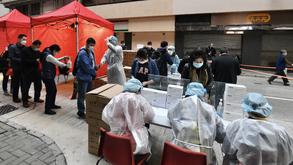 Residents wait in line to present negative COVID-19 results before leaving a cordoned-off area in North Point, Hong Kong, Jan 29, 2021. (PHOTO / INFORMATION SERVICES DEPARTMENT, HKSAR GOVT)
Residents wait in line to present negative COVID-19 results before leaving a cordoned-off area in North Point, Hong Kong, Jan 29, 2021. (PHOTO / INFORMATION SERVICES DEPARTMENT, HKSAR GOVT)
Medical experts and residents backed the Hong Kong government’s latest preemptive measure to cordon off high-risk areas for compulsory virus testing as the city continues to see a decline in COVID-19 cases.
On Wednesday, the city recorded 19 new infections, its lowest daily tally since Nov 20. Seven of the infections are untraceable. There are about 20 preliminary positives.
The number of daily infections have declined for the past week or so, compared with 81 infections recorded on Jan 23, the day the government first carried out an operation to seal off high-risk blocks in the Jordan area
The number of daily infections have declined for the past week or so, compared with 81 infections recorded on Jan 23, the day the government first carried out an operation to seal off high-risk blocks in the Jordan area, citing the high number of 162 positive cases in the first 20 days of January and high viral loads in the sewage system in the area.
Residents in the restricted area were not allowed to leave until they were tested and could produce negative results. Within 48 hours, the restrictions in Jordan were lifted after testing was completed. Up to 9 pm on Wednesday, 12 such operations took place, resulting in at least 14 positive cases.
ALSO READ: Nearly 2,200 residents tested for COVID-19 in three HK areas
Respiratory specialist Leung Chi-chiu said such mandatory testing in restricted areas is necessary to prevent community outbreaks, and sealing off an area can stop any possible asymptomatic patients leaving and preventing any outbreak from spreading further.
Leung noted that the selected lockdown areas, like Yau Tsim Mong, are densely populated and have a high mobility.
The recent lockdown operations by the government didn’t lead to many positive cases. But Leung said it is understandable since the city is seeing a drop in infections.
The government earlier noted that the low infection rates during the lockdown operations recently may be, in part, linked to the unwillingness of some residents to take the compulsory tests. Those who refuse to take the test are liable for a fine of HK$5,000 (US$645), according to the current regulation. And the government has warned of further actions, including forcibly breaking into homes with court warrants.
Leung expressed support for the authorities to get tougher on those who refuse to cooperate, to ensure more widespread mandatory testing and effective operations.
READ MORE: HK gets tough on residents who willfully ignore targeted testing
In the latest such operation, the government announced it would seal off Block D of Honour Building in To Kwa Wan from 8:30 pm on Wednesday, with the aim to lift the restriction at 6:30 am on Thursday. Leung suggested the authorities narrow the range and reduce the time spent on operations to minimize inconvenience to residents.
Those who refuse to take the mandatory virus test are liable for a fine of HK$5,000 (US$645), according to the current regulation. And the government has warned of further actions, including forcibly breaking into homes with court warrants
Infectious disease expert Joseph Tsang Kay-yan said he believes there was sufficient evidence for the government’s operations and that they were reasonably considerate. The operation also affected people who were visiting the area. Earlier, some clients at a Tsim Sha Tsui barbershop had to stay in it over night during a recent operation.
Tsang, who is the chairman of the Hong Kong Medical Association’s advisory committee on communicable diseases, said the complete sealing-off of an area is reasonable, explaining that if the environment is contaminated by the virus, even those who are only there for a brief time are likely to be infected.
In addition to targeting lock downs in residential buildings, he advised officials to strengthen testing in other high-risk spots, such as construction sites.
Several infection clusters involving construction workers were recorded in the fourth wave of the pandemic outbreak, including the latest 21 cases of those working on sites for the Hong Kong International Airport’s third runway and their close contacts.
Earlier, a free and voluntary testing program for construction workers rolled out by the government and contractors got a frosty reception from workers. Two days before the program ended on Jan 31, a lit tle over 22,000 workers were tested among over 100,000 active construction workers. Four infections were identified.
In an interview with China Daily, construction worker Yeung Lin-fung stressed the importance of having all residents collaborate with the government to render pandemic controls effective.
It takes only one asymptomatic patient who defies the government’s testing order to ruin socie ty’s efforts in pandemic control, Yeung said.
READ MORE: HK to double in-school teaching capacity as city sees 19 new cases
Painter Yeung Mui-na expressed her support for the government’s overnight lockdowns, saying that the measure — lockdown plus compulsory virus testing — is good for identifying asymptomatic patients and tracing transmission chains, especially in high-risk street blocks.
Yeung, who lives in Tai Po in the New Territories, said she is willing to comply with the government’s requirements if her home is listed in a lockdown zone. “It may be inconvenient in the short term, but beneficial to the city and all resi dents in the long term,” she said.


